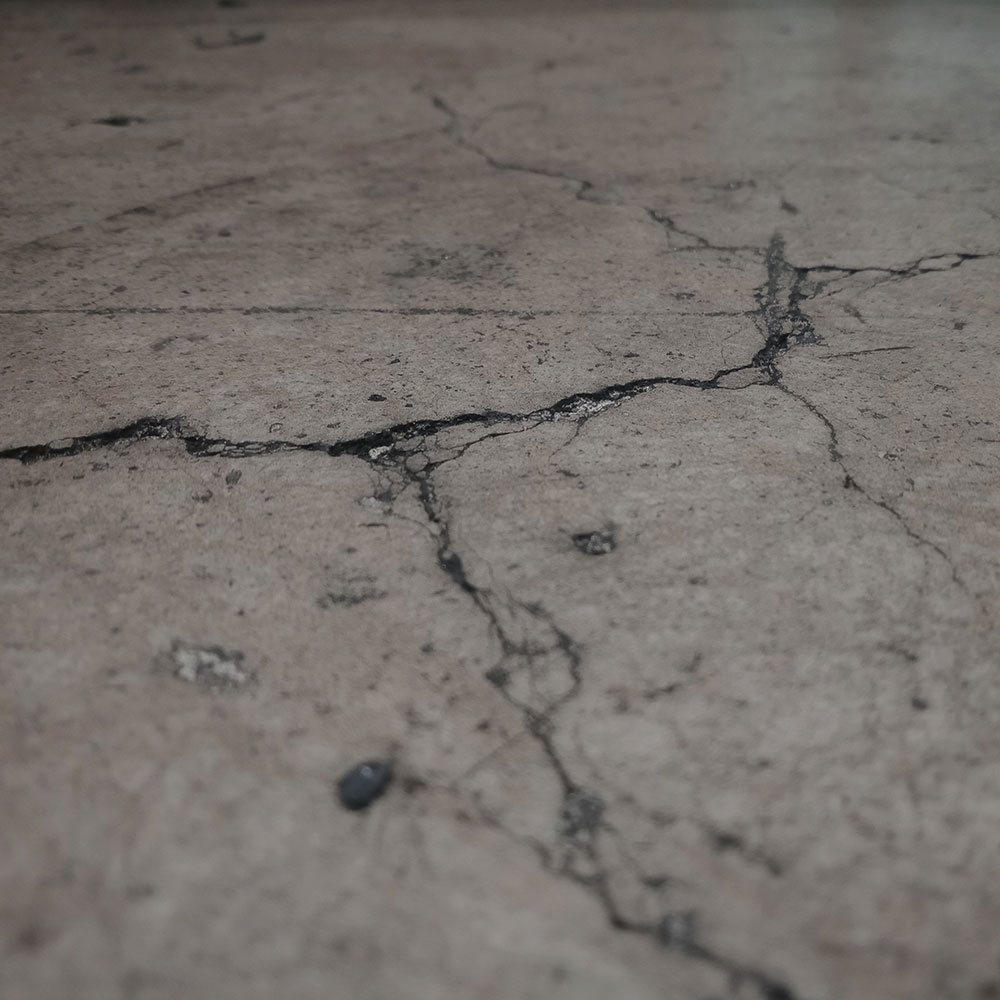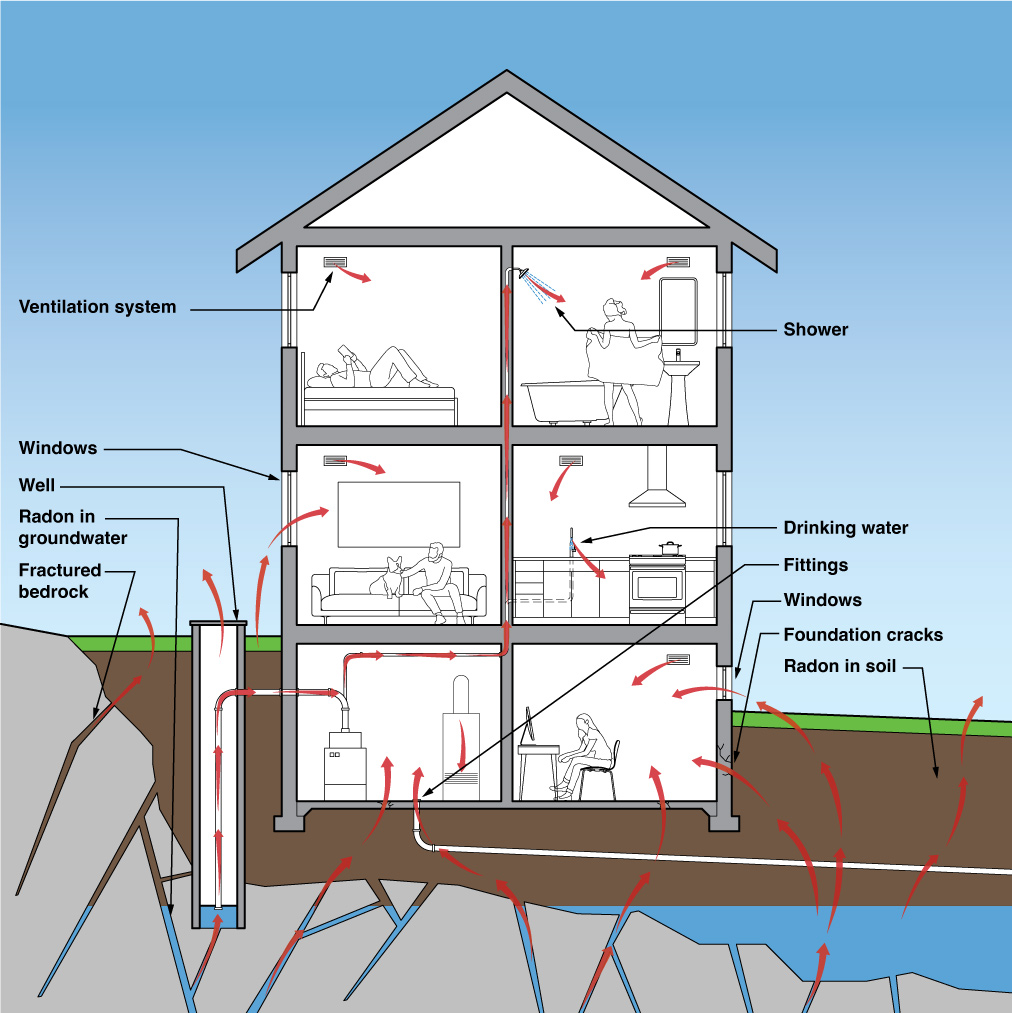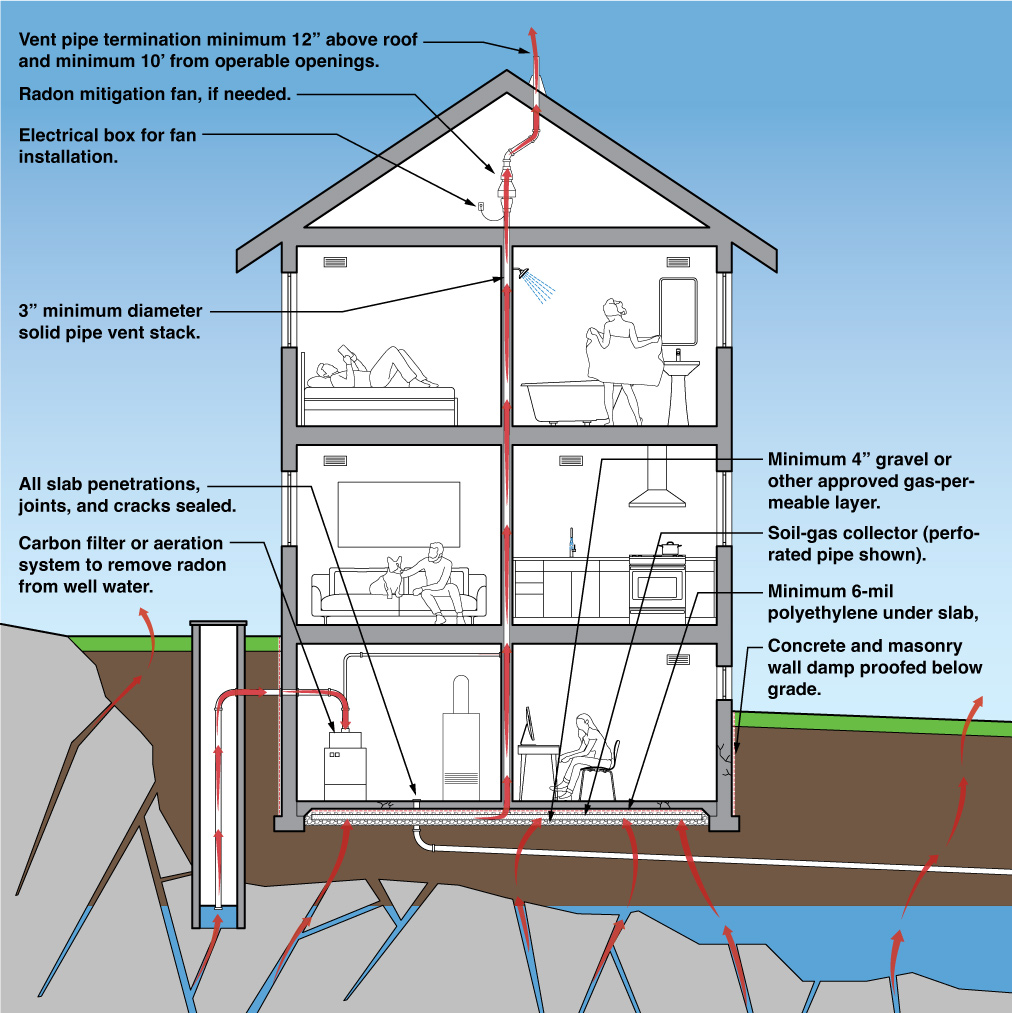
Radon is a radioactive gas with no color, odor, or taste. It is created from the natural breakdown of uranium which is found in all rocks and soils. As time passes, the uranium-rich rocks decompose and release radon gas naturally into the environment.
Outdoors, radon quickly dilutes to very low concentrations and is generally not a problem. (For reference, the average outdoor radon level varies from 5 – 15 Bq/m3 (becquerel per cubic meter).) However, concentrations are higher indoors and in areas with minimal ventilation, with the highest levels found in places like mines, caves, and water treatment facilities. In buildings such as homes, schools, and offices, levels can vary substantially from 10 Bq/m3 to more than 10,000 Bq/m3. Occupants of such buildings could unknowingly be living or working in spaces with very high radon levels.
Is that a problem?
Yes! As we breathe, the radioactive particles in radon gas deposit on the cells lining our airways, where they damage DNA and cause lung cancer. Exposure to radon is the second leading cause of lung cancer in the United States, after smoking.
How does radon get inside a building?
Radon gas releasing from the ground beneath buildings is the main source of radon in indoor air. Given that gas is atmospheric and formless, it is easy for small amounts to slip through gaps and cracks in building foundations. Some locations where radon enters a building include:
- Cracks in the basement floor.
- Cracks in foundation walls.
- Gaps at floor/wall junctions.
- Gaps around pipes or cables.
- Unsealed drains or sumps in basement floors.
- Water from bathroom showers and faucets (from contaminated well water).

While basements typically have the highest concentration of radon, rooms above grade can also have elevated levels. For example, if radon enters a forced-air ventilation system located in a basement, it is easily circulated throughout the entire house.
Can I test for it?
Yes. Every home should be tested, since radon is present in high concentrations in every state in the US. Further, your home can have elevated levels while your neighbor’s home does not. Testing is the only way to know if radon is a problem in your home.
Measuring radon levels is easy and inexpensive with the use of small passive detectors. There are two types of tests:
- Short term – measure levels for 2-90 days for quick results. This is good for real estate transactions.
- Long term – measure levels for more than 90 days for more accurate results. Since radon levels vary day to day and hour to hour, this is a preferable test—the longer the test, the more accurate it will be.
Your state radon office can give you information on where to get a test kit (free or discounted kits may be available). You can also purchase a test kit online, in many retail or hardware stores, or order one through the National Radon Program Services. The tests are simple for homeowners to perform themselves. Alternatively, you can hire an experienced professional to perform the testing.
Oh no! The test shows high levels of radon. What should I do?
Some simple, short term solutions include:
- Increase under-floor ventilation.
- Open the windows.
- Seal cracks in basement floors and walls.
- Improve overall building ventilation.
However, a long-term proven solution is to install a radon mitigation system (RMS). A RMS consists of a vent pipe installed below the lowest level of the home and terminating above the roof. Depending on conditions, a fan may or may not be needed. This simple set-up collects radon gas from underneath the foundation and vents it to the outside of your home.
If you have a well, a separate treatment system consisting of a carbon filter or aeration device can be added to your home’s water supply.

I’m planning a home remodel. Is a radon mitigation system required?
No, but it’s a good idea, especially if you are planning a major renovation, such as converting an unfinished basement into living space. Prior to your remodel, perform a radon test. If your test results indicate elevated levels, include radon-resistant techniques (identified above under short-term solutions) and a mitigation system as part of the renovation. Since major renovations can change the radon levels in any home, always test again after work is complete.
I’m building a new house. Is a radon mitigation system required?
Yes, under Oregon Statue ORS 455.365, all new public buildings and private residences built after April 1, 2013 in seven Oregon Counties (Baker, Clackamas, Hood River, Multnomah, Polk, Washington, and Yamhill) require Radon Resistant New Construction (RRNC). These requirements prevent radon from accumulating at harmful levels inside new buildings.
Radon resistant construction for new homes consists of:
- Installing gravel and plastic sheeting below all concrete slabs and any other floor systems in direct contact with the ground.
- Sealing foundation wall and basement slab cracks.
- Sealing openings around bathtubs, showers, water closets, pipes, wires, and other objects that penetrate concrete slabs or other floor assemblies.
- Sealing any air-handling units located in crawl spaces.
- Sealing any ductwork passing through or beneath a slab.
- Sealing around all penetrations through floors above crawl spaces.
- Gasketing all crawl space access doors and other openings between basements and adjoining rooms to prevent air leakage.
- Installing a minimum 3” diameter vent pipe from the lowest level of the home through the roof.
- Installing an electrical circuit in an approved j-box in the location of an anticipated vent pipe fan.
- Performing a radon test after construction is complete.
- Installing a fan if levels are still elevated.
What’s next?
Like lead and asbestos, radon is dangerous stuff. And Portland is a hot spot, with the Alameda Ridge having the highest concentration in the city. Whether you’re planning a major remodel or building a new house, CA can help specify a mitigation system that is right for you. Let us know how we can help.
